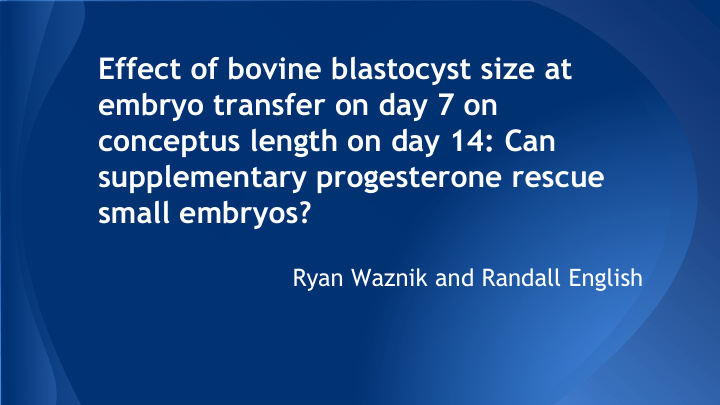



Effect of bovine blastocyst size at embryo transfer on day 7 on conceptus length on day 14: Can supplementary progesterone rescue small embryos? Ryan Waznik and Randall English
Key Reproductive Terms ➢ Progesterone- hormone that is responsible for maintenance of pregnancy ➢ Corpus Luteum (CL) ○ ovarian structure that secretes progesterone after ovulation ➢ Human Chorionic Gonadotropin (hCG)- ○ induces ovulation of a dominant follicle that forms an accessory corpus luteum (CL), thus increases circulating P4 concentration slowly ➢ Progesterone releasing intravaginal device (PRID) ○ exogenous progesterone insert that increases P4 rapidly ○ ➢ Prostaglandin F2 𝞫 lyses the CL and restarts estrus cycle ○ ➢ Superovulation ○ production of multiple oocytes at one time with the use of follicle stimulating hormone (FSH)
What is Embryo Transfer? ➢ 10,000-12,000 heifer calves are produced per year due to embryo transfer (ET) ➢ First calf produced in 1951 ➢ A surgical or nonsurgical technique used to transfer embryos from a donor cow to a recipient cow ○ used to produce superior female genetics ○ multiple offspring from donor
Steps of Embryo Transfer ➢ 3 Steps of Embryo Transfer ○ Donor cow selection and superovulation ○ Flushing (collection) of embryos ○ Recipient female synchronization and transfer
What Questions are asked? ➢ Main Question: Can elevated progesterone levels rescue small blastocysts by increasing conceptus size? ➢ How do the treated cow’s progesterone levels compare to the controls for the first two weeks after estrous? ➢ Is there a relationship between the size of an embryo at embryo transfer and the size of the conceptus it forms after a week of growth?
Main Hypothesis The present study was designed to test the hypothesis that supplemental P4, through hCG administration on Day 2 or insertion of a PRID between Days 3 and 5, would promote elongation of a small blastocyst with a low total cell number at the time of transfer, that is, P4 “priming” of the uterine environment can overcome the decreased developmental potential of embryos with small cell number. ➢ Sub-hypothesis: By increasing conceptus size on Day 14, we can ○ increase pregnancy rates.
Embryo Production ➢ Immature Cumulus oocyte complexes (COCs) were aspirated from slaughtered heifers and cows ➢ Matured for 24 hours in vitro ➢ Mature COCs were inseminated in vitro from the frozen-thawed sperm of a single bull ➢ 20 hours after insemination, the embryos were isolated from cumulus cells and accessory sperm, and were cultured until day 7 ➢ Classified by size at day 7 as large or small based on estimated cell number from diameter lengths ➢ Embryo transfer into recipient heifers
Experimental Design (Figure 1) ➢ P4 (days -8 to -2) and PG (day -3) were used to synchronize estrous cycles to standing at day zero in recipient heifers. ➢ Treatment groups received either hCG at day 2 or PRID from days 3 to 5. ➢ At day 7, blastocysts transferred to the recipient heifers via ET. ➢ The heifers were slaughtered at day 14 for conceptus recovery. ➢ Blood was sampled from days 0 to 14.
Data Collection ➢ Blood samples collected daily from day 0 to day 14 measured progesterone concentrations ○ ➢ Day 7 blastocysts collected diameter measured ○ ○ some stained with bisbenzimide to measure cell number and ➢ Conceptus recovery on day 14 recovery rates of conceptuses versus number of embryos transferred ○ were measured length, width, and weight were measured ○ ➢ CL dissection of slaughtered heifers weighed and measured for dimensions ○
Progesterone Levels (Figure 2) ➢ Control small and control large had similar progesterone levels ➢ PRID had Significantly higher progesterone on days 4-5 ➢ hCG group yielded higher progesterone from days 6- 13, but only significantly on day 8.
Conceptus Recovery (Table 1) ➢ Each heifer received 10 embryos ➢ PRID had significantly less % recovered from transfers than control large ➢ hCG had significantly less % recovered from yielding heifers than all other groups
Conceptus Dimensions (Figure 3) ➢ Measured in mm for length and width, and mm^2 for area ➢ PRID had significantly greater elongation and area ➢ Small control had smaller conceptus dimensions than large (not sig.) ➢ hCG had greater length and area than small control
Measurements of CL (Figure 4) ➢ No significant differences in luteal tissue weight ➢ PRID had a lower luteal area than all other groups ○ is this surprising?
Discussion ➢ Increased elongation in day 14 conceptuses was seen in treatment, especially PRID ➢ The treatments did not show an increase in recovery of conceptuses Though quantity did not increase, quality via measurement of ○ elongation could lead to fewer miscarriages later on and higher birth rates in treatments ➢ PRID method shortens cycles, but can help conceptus elongation ➢ Combined methods of PRID and hCG have shown to help cycles, but have not been evaluated for effect on conceptus elongation ➢ Further studies could look more into the utilization of combined techniques to see its potential usefulness in elongation without as much damage done to the CL
Limitations ➢ High variation in embryo size ➢ Short term study ○ Why was the study short term? In order to evaluate short term elongation ■ ○ Cannot answer whether bigger is better ➢ Only measured 1 hormone level What other compound concentrations might be relevant to the ○ study? INFT, mentioned to be affected by progesterone ■ ■ Estradiol and inhibin A, products of the CL
Main Conclusions ➢ Supplementation of P4 can rescue small embryos ➢ Blastocyst cell count at day 7 is correlated to day 14 conceptus length ➢ The PRID method has shown to have a marked increase in day 14 conceptus length
Sources http://upload.wikimedia.org/wikipedia/commons/6/6b/E mbryo,_8_cells.jpg http://www.bairnsley.com/Web%20Photos/AI%20- %20ET%20flush%20diagram.jpg http://www.davis-rairdan.com/embryo-transfer.htm http://msucares.com/pubs/publications/p2681.pdf http://www.ncbi.nlm.nih.gov/pubmed/12604631 http://www.jbc.org/content/269/40/24826.full.pdf
Recommend
More recommend